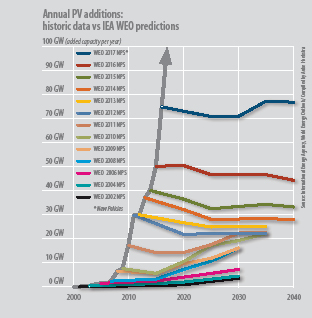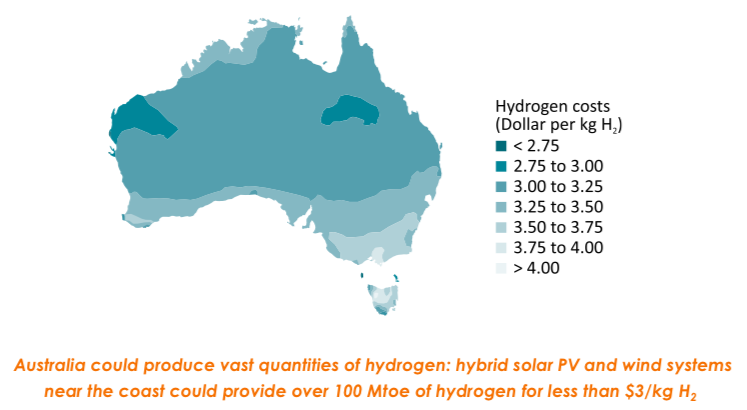The International Energy Agency (IEA) has highlighted the potential of Australian renewable hydrogen in its annual World Energy Outlook publication. While the IEA’s annual ‘flagship’ publication frequently draws the ire of renewable advocates, its spotlight on hydrogen production powered by wind and solar in Australia’s north makes for welcome reading.
The IEA examination of renewable hydrogen production notes, “Australia’s potential to produce hydrogen fuel in this way could be vast.” It finds that the cost of producing hydrogen through electrolysers located in close proximity to wind and solar farms in northern Australia could come in at US$3/kg H2 in 2040. This makes it cheaper than doing so using natural gas, when the costs of carbon capture are included.
“Australia has excellent solar and wind resources (often in close proximity) and has launched a number of pilot projects aiming to accelerate the development of hydrogen technologies,” writes the IEA. “We looked for the optimal combination of solar PV, wind and electrolyser capacity in a hybrid system located at all points across the country, taking into account costs and the capacity factors of renewable electricity technologies.”
Using only locations 50km from the coast, for ease of export shipment, excluding ‘protected sites’ and those used for other uses or with insufficient water resources, the IEA found that northern Australia could produce 100 million tons of oil equivalent (Mtoe). This is equal to 3% of global gas consumption today.
For electricity inputs, the IEA found renewable electricity costs in these regions would be below US$47/MWh – with combined solar+wind capacity factors of 30-40%.
“This 100 Mtoe of hydrogen could be manufactured at less than $3/kg H2. While this would be nearly double the projected cost of producing hydrogen in 2040 from steam methane reformation, it would be closer to the costs of such a system equipped with CCUS [carbon capture and storage].”
The IEA notes that costs could be lower if the government provided support for such projects, or solar, wind and/or electrolyser costs declined quicker than expected.
The case study of renewable hydrogen production in Australia was featured in chapter 9 of the IEA’s World Energy Outlook 2018, titled Electricity Futures.
More generally, the IEA has sought to highlight the central role of government policy in transforming the global energy system to a low-carbon basis in its 2018 report. It charts the slow decline of coal as an energy source, however notes that the rate of transformation, according to the majority of its scenarios, is well behind targets set by the Paris Climate Accord.

Graphic: pv magazine/Harald Schütt
The IEA’s WEO has consistently underestimated the growth of solar in the global energy system in its scenarios – it balks from making actual forecasts. Its 2018 report notes: “Solar PV is charging ahead, but other low-carbon technologies and especially efficiency policies still require a big push.”
In fact, while some may question the numbers, in its 2018 report the IEA tips installed solar PV capacity to overtake that of all other forms of energy apart from gas by 2040.
This content is protected by copyright and may not be reused. If you want to cooperate with us and would like to reuse some of our content, please contact: editors@pv-magazine.com.









By submitting this form you agree to pv magazine using your data for the purposes of publishing your comment.
Your personal data will only be disclosed or otherwise transmitted to third parties for the purposes of spam filtering or if this is necessary for technical maintenance of the website. Any other transfer to third parties will not take place unless this is justified on the basis of applicable data protection regulations or if pv magazine is legally obliged to do so.
You may revoke this consent at any time with effect for the future, in which case your personal data will be deleted immediately. Otherwise, your data will be deleted if pv magazine has processed your request or the purpose of data storage is fulfilled.
Further information on data privacy can be found in our Data Protection Policy.